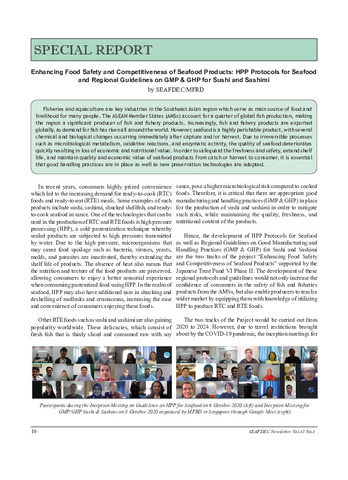| dc.date.accessioned | 2021-03-24T03:14:55Z | |
| dc.date.available | 2021-03-24T03:14:55Z | |
| dc.date.issued | 2021-03-24 | |
| dc.identifier.uri | http://hdl.handle.net/20.500.12066/6637 | |
| dc.description.abstract | Fisheries and aquaculture are key industries in the Southeast Asian region which serve as main source of food and livelihood for many people. The ASEAN Member States (AMSs) account for a quarter of global fish production, making the region a significant producer of fish and fishery products. Increasingly, fish and fishery products are exported globally, as demand for fish has risen all around the world. However, seafood is a highly perishable product, with several chemical and biological changes occurring immediately after capture and/or harvest. Due to irreversible processes such as microbiological metabolism, oxidative reactions, and enzymatic activity, the quality of seafood deteriorates quickly resulting in loss of economic and nutritional value. In order to safeguard the freshness and safety, extend shelf life, and maintain quality and economic value of seafood products from catch or harvest to consumer, it is essential that good handling practices are in place as well as new preservation technologies are adopted. | en |
| dc.language.iso | en | en |
| dc.publisher | Secretariat, Southeast Asian Fisheries Development Center | en |
| dc.title | Enhancing Food Safety and Competitiveness of Seafood Products: HPP Protocols for Seafood and Regional Guidelines on GMP & GHP for Sushi and Sashimi | en |
| dc.type | Book chapter | en |
| dc.citation.spage | 10 | en |
| dc.citation.epage | 11 | en |
| dc.citation.bookTitle | SEAFDEC Newsletter Vol.43 No.4 | en |
| dc.contributor.corporateauthor | Marine Fisheries Research Department, Southeast Asian Fisheries Development Center | en |

